 W
WAgua Caliente County Park is a 910 acres park with geothermally heated springs. The park is located just west of Anza-Borrego Desert State Park, in eastern San Diego County, California. Agua Caliente is located about 110 miles (180 km) east of downtown San Diego. Spring water feed pools include an outdoor swimming pool, an outdoor wading pool for children, and an indoor 102 °F (39 °C) therapeutic spa. Site amenities include a caravan area, full and partial hookup RV sites, non-hookup sites, tent camping, and cabins. Facilities include shuffle board, horseshoes, day use picnic area, and dressing rooms. 3.95 miles (6.36 km) hiking trails from flat terrain to steep rocky trails.
 W
WA toiletry bag is a portable container—usually a pouch with a drawstring or zippered closure—which holds body hygiene and toiletry supplies such as toothbrush and toothpaste, dental floss, cotton swabs, deodorant, nail clippers, tweezers, soap, shaving supplies, hair brush, tampons, contact lenses and supplies, and similar items while travelling and in other circumstances where permanent shelves and cupboards are unavailable or impractical for use.
 W
WThe Loop C Comfort Station and the Loop D Comfort Station are public toilet facilities in Bryce Canyon National Park's North Campground, individually listed on the National Register of Historic Places in 1995 for their significance as structures relating to the park's administrative infrastructure, and for their integrity as examples of rustic architecture. The National Park Service rustic style structures were built in 1935 as part of the first planned campground in the park by Civilian Conservation Corps labor. Plans were developed by the National Park Service Branch of Plans and Designs. Similar facilities in Loops A and B were not built until the 1950s.
 W
WCamp Nauʻe YMCA is a 12-acre beachfront campground on the north shore of Kauai, Hawaii. It contains five bunkhouses (cabins), bathrooms, showers, a pavilion, a kitchen and a dining hall. It is used by visiting campers as well as local youth groups. The campground is located directly on Haena Beach. Naue literally means "to move" in Hawaiian.
 W
WCamp Walt Whitman is a traditional, overnight, and co-educational summer camp located in Piermont, New Hampshire along the shore of Lake Armington. It was founded in 1948 by Arnie and Chick Soloway and has remained in the family; it is today run by Carolyn and Jed Dorfman. It is named after poet Walt Whitman.
 W
WA canteen is a drinking water bottle designed to be used by hikers, campers, soldiers and workers in the field of the people in the early 1800s. It is usually fitted with a shoulder strap or means for fastening it to a belt, and may be covered with a cloth bag and padding to protect the bottle and insulate the contents. If the padding is soaked with water, evaporative cooling can help keep the contents of the bottle cool. Many canteens also include a nested canteen cup.
 W
WColeman fuel is a petroleum naphtha product marketed by the Coleman Company.
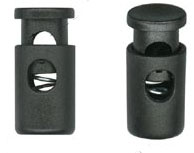 W
WA plastic cord lock attaches to drawstrings and tightens without the use of knots. Cord locks allow mountaineers to fasten clothing and camping equipment quickly in cold conditions when the fingers are encased in heavy gloves. They consist generally of three parts: a barrel, a toggle (plunger), and a spring. Squeezed together, tension is released and the cord lock can move freely up and down the cords. Released, the tension is engaged and the cord lock stays in place. They come in many sizes and shapes to suit to any purpose, including plastic cord lock, mini size cord lock, no spring cord lock, with spring cord lock, with rim cord lock.
 W
WCorn Creek Campsite is located in the Desert National Wildlife Range and was used from around 1900–1924 for ranching and is listed on the United States National Register of Historic Places. Nearby is Mormon Well Spring another listed historic place.
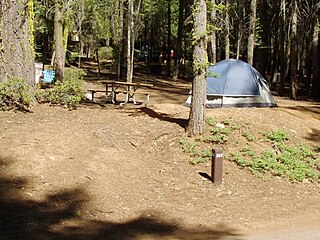 W
WCrane Flat Campground, elevation 6,200 feet (1,900 m), is located in Yosemite National Park, 17 miles (27 km) northwest of Yosemite Valley. Of all campgrounds outside of Yosemite Valley, Crane Flat is the closest to the Valley in terms of mileage and travel time. The campground is directly off the road. Each campsite contains a fire ring, picnic table, and food locker, and is near a bathroom with potable water and flushing toilets.
 W
WDispersed Camping is the term given to camping in the United States on public land other than in a designated campsites. This type of camping is most common on national forest and Bureau of Land Management land. Designated campsites often offer services to the campers, such as trash removal, toilet facilities, tables and/or fire pits, which are not available at dispersed camping locations. Although dispersed camping takes place on public land, each managing agency has specific regulations for dispersed camping, though they generally all also require campers to follow Leave No Trace guidelines. Other terms used for this type of camping can be boondocking, dry camping or wild camping.
 W
WThe Elwha Campground Community Kitchen was built in Olympic National Park to serve the Altair Campground. It is an open octagonal shelter built in 1935 by the Civilian Conservation Corps personnel from the Elwha River Camp in the National Park Service Rustic style. The peeled log structure is capped with a cedar shake roof, enclosing a cooking fireplace and chimney. The Elwha and Altair Campground Community Kitchens are the only such structures remaining in Olympic National Park.
 W
WA firelighter is a small, solid fuel tablet for fire making. Firelighters marketed as consumer products may be used to start a wood or coal fire in a fireplace, wood-burning stove, or solid-fuel portable stove.
 W
WA fly refers to the outer layer of a tent or to a piece of material which is strung up using rope as a minimalist, stand-alone shelter. In basic terms, a fly is a tent without walls. Purpose-made stand-alone flies are also sometimes referred to as bivouacs, bivvies, tarpaulins, or hootchies. Flies are generally used for keeping moisture or sun off people while they eat, rest or sleep. They can also be used as groundsheets, but this is not recommended since it creates wear and tear which can lead to holes.
 W
WThe Glacier Basin Campground Ranger Station in Rocky Mountain National Park was built in 1930 to a design by the National Park Service Branch of Plans and Designs. The National Park Service Rustic log and stone structure was designed to blend with the landscape, and continues to function as a ranger station.
 W
WHagan-Stone Park is a 409-acre (1.66 km2) wildlife refuge and family campground owned and operated by Guilford County, North Carolina located on Hagan Stone Park Road off U.S. Highway 421. It is open daily 8 am to sunset, weather permitting.
 W
WHappy Jack is an unincorporated community and campground located in the Mogollon Rim Region of Coconino County, Arizona, United States. The Lowell Discovery Telescope is located there.
 W
WLake Harris Campground is a campground operated by the New York State Department of Environmental Conservation (DEC) on Harris Lake in the town of Newcomb, New York in the Adirondacks. The campground is open from mid-May through early September.
 W
WRobert E. Lee Campground is a United States Forest Service campground in the Boise National Forest about 40 miles (64 km) east of the state capital, Boise. It is situated at North Fork Boise River river mile 19, at the confluence of Robert E. Lee Creek, a short tributary. The campground and creek, both named for General Robert E. Lee, are the only two Confederate memorials in the U.S. state of Idaho. It is at 4,800 feet (1,500 m) in elevation and has six campsites.
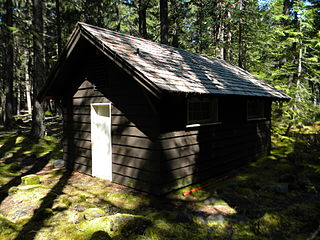 W
WThe Longmire Campground Comfort Stations were built in the early and mid-1930s in Mount Rainier National Park to provide public toilet facilities to automobile tourists camping in the park at Longmire. Essentially the same in design, the facilities were designed by the National Park Service Branch of Plans and Designs. Their construction was supervised by park landscape architect Ernest A. Davidson. The timber frame buildings followed the tenets of the prevailing National Park Service Rustic style.
 W
WOriginally, half of a Finnish conical tent called a laavu, the contemporary loue, redesigned by brands such as Finnrover and Vihe Vaellus, is an ultra-light Finnish open tent-like shelter. It is used to give reasonable protection from wind and rain during a variety of outdoor adventures, including camping, canoeing, hiking and hunting. Loues are popular with Scout groups and minimalist campers. Suitable as one or two person shelters, they are compact, light and can be set up and taken down in a basic way fairly quickly. The workman-like sets shown in photographs indicate that more effort can be made to stiffen the sides and the stakes and lines used can complicate a taut setup. The open front permits fire viewing, ventilation and looking out over a scenic view. A loue consists of a roughly conical section of fabric with the semi-circular bottom edge grounded by stakes and the tip raised with a single pole. Suitable standing tree trunks may be used to suspend the tent if an open campfire is not to be used. This style of ''tarp tent" can best be raised using a scissors-pole assembly. A pole suspension system allows for positioning an open fire in front of the shelter without the risk of damaging tree trunks or roots. The panels of a true Finnish loue are designed to provide a semi-circular short wall around the shelter and a triangular piece at the tip can be let down to provide a little more shelter in front. With suitable siting and careful staking and tensioning, the side walls can be set close to the ground, providing protection from drafts and lifting from winds.
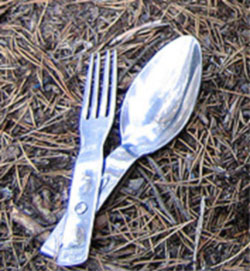 W
WLusikkahaarukka is a stainless steel, folding spoon-fork combination issued together with a mess kit in the Finnish Army. It is widely used in camping and outdoors activities.
 W
WThe Many Glacier Campground Camptender's Cabin in Glacier National Park is an example of the National Park Service Rustic style. Built in 1934, the small cabin is significant for its association with park visitation patterns, auto camping, and NPS rustic architecture.
 W
WMount Carmel A.M.E. Zion Church & Campground is a historic African Methodist Episcopal Zion church camp in Heath Springs, South Carolina, Lancaster County, South Carolina. It was established in 1866 and consists of a complex of approximately 55 small "cabins" or "tents" and the brick church of Mt. Carmel A.M.E. Zion Church is located in the general form of a rectangle. Mount Carmel A.M.E Zion Church Campmeeting starts every year on the first Wednesday in September, and last for 4–5 days. An "arbor," or open-air structure, is located in the center of the complex, where music, gospel singing, praise and worship, preaching and teachings are held. People come to worship, fellowship, network, and eat food from as far as New York City, NY to Orlando, FL. There is also a section on the grounds for vendors. The majority of the cabins are small frame, some are two story cabins for larger families made from concrete block and wooden structures. Also on the property is the church cemetery.
 W
WThe National Bikers Roundup is the largest camping motorcycle rally in the United States and is organized by a group of African American motorcycle clubs. Its location changes every year but every decade it returns to its founding city of Kansas City, Missouri. More than 1,000 motorcycle clubs attend the event and black women make up close to half of participants.
 W
WNorthern Bay Sands is a popular beach and campgrounds in Northern Bay, Newfoundland and Labrador, Canada. In 1775, a ship supposedly crashed off the coast of the beach due to the Great Hurricane of 1775. Throughout the 19th and early 20th century the beach was used as a site for gutting, cleaning and salting fish in the small-boat cod fishery. After Confederation, the beach became a provincial park.
 W
WOcknell Plain can be found in the New Forest near Southampton, England.
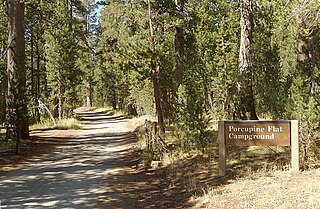 W
WPorcupine Flat Campground, located in northern area of Yosemite National Park along Tioga Road, is a first-come first-served campground outside of Yosemite Valley. This campground is very remote, very quiet, and very unpopulated relative to other campgrounds in Yosemite. The campground is directly off the road and thus does not require a rough drive to the campground like other Yosemite campgrounds outside of the Valley. Porcupine Flat is directly along a branch of Snow Creek and therefore many of the sites inside the campground are directly alongside a running creek. Those looking to stay away from crowds/noise should consider this campground. The sites are very green and shaded by the trees in the area. Deer are often seen grazing in the campground.
 W
WThe Rock Fort Campsite is a natural fortification on the south shore of the Columbia River in The Dalles, Oregon, United States. The Lewis and Clark Expedition camped at this defensible spot for three nights in late October 1805, just after it passed Celilo Falls on its descent to the Pacific Ocean, and again for one night on their return journey. It was here that the expedition first made significant contact and commerce with the Chinookan-speaking peoples of the lower Columbia.
 W
WThe Roes Creek Campground Camptender's Cabin, also known as the Rising Sun Campground Ranger Cabin, in Glacier National Park is an example of the National Park Service Rustic style.
 W
WA roof tent is an accessory which may be fitted to the roof of a motor vehicle which allows the users to sleep in relative safety and comfort above the vehicle, and leaves the internal load-space free. The first example of roof-tents appeared in Western Europe in the 1930s.
 W
WRuckle Provincial Park is a provincial park on Salt Spring Island, British Columbia, Canada. It has the largest provincial campground on the Gulf Islands. Partly protected by the park is a historic sheep farm founded by the Ruckle family.
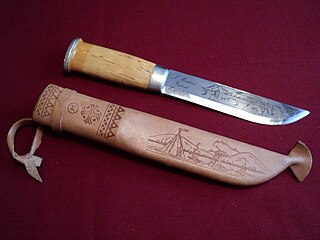 W
WThe Sami knife, is a large knife traditionally used by the Sami people.
 W
WA Sierra cup is a cup used for camping or Backpacking. Sierra cups are wider at the top than bottom, allowing for stacking. They typically have a fixed wire handle that is formed into a hook for attaching the cup to a belt. Some products, which use the name "sierra cup," have straight handles or handles that can fold away or be removed to save storage space. The cup is normally made of stainless steel, although other materials such as aluminum, titanium, and plastic have also been used.
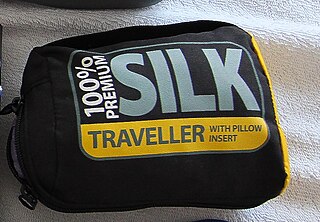 W
WSleeping bag liners are lightweight cloth sacks usually fitted inside sleeping bags to provide extra comfort, insulation, and help keep the sleeping bag clean.
 W
WTamarack Flat Campground is located in Yosemite National Park about 20 miles (32 km) from the Valley at an elevation of 6,300 feet (1,900 m). There are 52 campsites and all are issued under a first-come first-served basis. There is a 3 miles (4.8 km) unpaved road leading from the main road downhill to the campground.
 W
WA tarp tent is a tarpaulin, a plastic or nylon sheet, used in place of a tent. It is usually rigged with poles, tent pegs, and guy lines. Ultralight backpackers use tarp tents because they are lightweight compared to other backpacking shelters.
 W
WThe Timber Creek Campground Comfort Stations are a set of three historic public toilet facilities in Rocky Mountain National Park. Designed in 1935 by landscape architect Howard W. Baker of the National Park Service Branch of Plans and Designs, the National Park Service Rustic buildings were built with Civilian Conservation Corps labor in 1939. They were added to the National Register of Historic Places on January 29, 1988.
 W
WA tree tent is a camping tent designed to be set above the ground, usually attached to or supported by the neighboring trees. Like a tent, it must be a complete enclosure that can house a camper and his or her gear while suspended off the ground. Like tree houses, a tree tent may be accessed via a rope ladder and provide a sheltered environment for recreation and various outdoor activities. The portable nature of this type of shelter provides for more versatile location choice than a conventional tree house or a camping tent.
 W
WA tumpline is a strap attached at both ends to a sack, backpack, or other luggage and used to carry the object by placing the strap over the top of the head. This utilizes the spine rather than the shoulders as standard backpack straps do. Tumplines are not intended to be worn over the forehead, but rather over the top of the head just back from the hairline, pulling straight down in alignment with the spine. The bearer then leans forward, allowing the back to help support the load.
 W
WThe Two Medicine Campground Camptender's Cabin in Glacier National Park is an example of the National Park Service Rustic style. Built in 1923 and altered in 1992, when it gained electricity, it was the chief point of administrative contact in the park's Two Medicine area and served as a seasonal ranger residence.
 W
WUtvika Camping is a camping spot close to the Tyrifjorden. Perhaps mostly known as the place where most of the survivors of the 2011 Norway attacks at Utøya were taken when rescued by boat owners in the area.
 W
WYosemite Creek Campground, located in the northern area of Yosemite National Park along Tioga Road, is a first-come first-served campground outside of Yosemite Valley. This campground is remote, quiet, and less populated relative to other campgrounds in Yosemite. The campground is 4 miles off the main road and thus requires a very rough, single lane, downhill mostly unpaved drive to the campground.